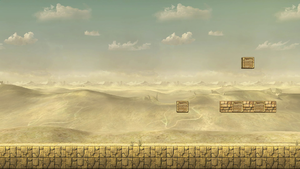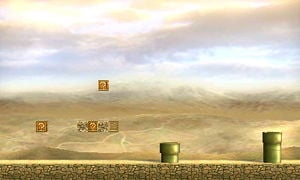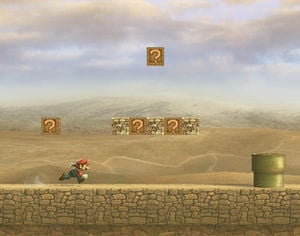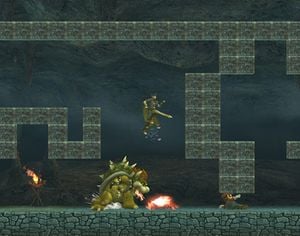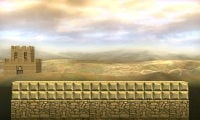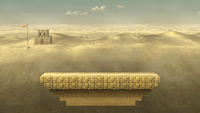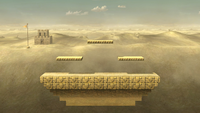Mushroomy Kingdom
| Super Mario Bros. Mushroomy Kingdom | |
|---|---|
 Mushroomy Kingdom across the series. | |
| Universe | Mario |
| Appears in | Brawl SSB4 (3DS) Ultimate |
| Availability | Starter |
| Crate type | Normal |
| Articles on Super Mario Wiki | World 1-1 (Super Mario Bros.) World 1-2 (Super Mario Bros.) |
Mushroomy Kingdom (いにしえっぽい王国, Ancient‐Like Kingdom) is a stage in Super Smash Bros. Brawl based off levels in Super Mario Bros. This stage is a 2.5D (3D structure in a 2D perspective) replica of the original World 1-1 with enhanced graphics and a deserted theme. Ruins can be seen in the background and life is absent apart from the fighters. Game director Masahiro Sakurai stated in the stage's update on the Smash Bros. DOJO!! that he wanted to create the impression that the kingdom had been abandoned since its initial appearance in 1985, 23 years prior to the release of Brawl. The stage returns as a familiar stage in Super Smash Bros. for Nintendo 3DS and Super Smash Bros. Ultimate, albeit with the World 1-2 version removed.
In for Nintendo 3DS, Dr. Mario is fought here in his unlocking battle.
Stage overview[edit]
The stage scrolls to the right slowly and one can see familiar Mario landmarks like the flagpole and castle at the end of the level, but it keeps on scrolling, looping back to the level's start. There are both destructible Brick Blocks, as well as indestructible ? Blocks, which release an item when struck, similar to their Super Smash Bros. Melee appearance. Blocks that contained multiple coins in Super Mario Bros. will release multiple items (up to three) if hit more than once.
In Brawl, Mushroomy Kingdom can also load as World 1-2, an underground stage. This stage has many Brick Blocks that need to be destroyed to pass through, and ends at the same pipe that it did in Super Mario Bros, but players must jump over it to continue fighting. Originally, this was where the first Warp Zone was situated. Its removal makes it one of the only features of the two levels that was not recreated for Brawl.
Ω forms and Battlefield form[edit]
In Super Smash Bros. for Nintendo 3DS, the Ω form features a flat platform made of Hard Blocks with Ground as the base. The stage is set past the castle. The stage does not scroll, and the platform extends below the blast line.
In Super Smash Bros. Ultimate, the Ω form and Battlefield form are nearly identical to SSB4's Ω form; however, the floor of the platform is now just made of Ground. The platform also does not extend below the blast line, and it is resized and reshaped to match Final Destination and Battlefield, respectively. The three soft platforms of the Battlefield form are made of Hard Blocks. Additionally, Screen KO's are replaced with Star KO's.
Hazards Off[edit]
With hazards off on Ultimate, the ? blocks are empty and the brick blocks are indestructible. The stage still scrolls as usual.
Level selection[edit]
When Mushroomy Kingdom is played in Brawl, World 1-1 and World 1-2 each have a 50% chance of loading. However, it is possible to choose which version of the stage to play by holding down a certain button while selecting it on the stage selection screen. The following guide indicates which button to hold using the default controls:
- World 1-1
- World 1-2
Origin[edit]

This stage is based on World 1-1 and World 1-2 of Super Mario Bros., and the stage is a mostly accurate replica of their layouts. However, several small changes were made to facilitate gameplay: all enemies and coins were removed, all Warp Pipes were made inaccessible, with the vertical ones shortened, and World 1-2's Warp Zone was replaced with a loop back to the beginning of the stage. In World 1-1, the hidden 1-Up Mushroom block was lowered by one block, and the block the flagpole stood on was removed (except in Ultimate, where it is in the background). In World 1-2, the grounded Brick Blocks after the three pipes and near the exit were changed to Ground.
However, two elements from Super Mario Bros. are retained: ? Blocks that release an item upon being hit, and Brick Blocks that break upon being hit. Additionally, the flagpole and castle found at the end of World 1-1 also appear, though relegated to background elements.
As stated before, the game director of the Super Smash Bros. games, Masahiro Sakurai, said in the stage's update on the Smash Bros. DOJO!! that he wanted to create the impression that the levels have had been abandoned since their initial appearance in 1985, 23 years prior to the release of Brawl.
Tournament legality[edit]
Due to the stage's sidescrolling nature and ledges that can't be grabbed, this stage is banned from official tournaments. World 1-2 also has an unusually low ceiling, and it is possible to KO with up throws at 0%. The blocks can additionally create caves of life, especially on World 1-2.
Update history[edit]
- Mushroomy Kingdom's on-screen appearances and revival platforms locations have been changed.
Gallery[edit]
Origin[edit]
Super Smash Bros. Brawl[edit]
Super Smash Bros. for Nintendo 3DS[edit]
Mushroomy Kingdom in Super Smash Bros. for Nintendo 3DS.
Super Smash Bros. Ultimate[edit]
Dr. Mario jumping on the stage.
Meta Knight and Roy jumping towards a Fake Smash Ball on the stage.
Sonic dashing on the stage.
Names in other languages[edit]
Trivia[edit]
General[edit]
- This stage's Japanese name is a reference to the previous Smash stages named Mushroom Kingdom in English, the Japanese names of which were more literally "Ancient Kingdom," referring to their retro designs. Mushroomy Kingdom is instead "ancient" as it appears in ruins, but its graphics have also been updated, so its Japanese name, translating to "Ancient‐Like Kingdom," is a play on this variation of the idea. It is referred to as "Mario_PastX" in Ultimate's files.
- The stage's scrolling speed is such that the stage reaches the goal (Brawl; the flagpole for 1-1 or pipe for 1-2) or makes exactly one loop in two minutes, the default time for a timed match. In for Nintendo 3DS, the stage doesn't perfectly loop after two minutes, needing an additional half-second to do so.
- Players are unable to enter the pipes in this stage because they are grated out, as revealed by rotating the camera.
- This stage's World 1-2 variant and the grayscale version of Dream Land GB are the only differently loaded versions of stages not in Ultimate.
Super Smash Bros. Brawl[edit]
- On the World 1-2 version of this stage, it is possible to dodge Olimar's End of Day by standing on the very top of the level for the duration of his attack.
- During Sudden Death (where items are usually absent), players can still get items from ? Blocks.
- When the black palette of Mr. Game & Watch is used on World 1-2, he appears to be dark yellow. This could possibly be a reference to the color-changing sprites in the original Super Mario Bros., though it's more likely that this is done to make him easier to distinguish from the dark background.
- Oddly, within the Album, the palette switches back to black.
- Instead of Space Jumping when offscreen like in the Subspace Emissary, Pokémon Trainer instead appears at the other side of the screen with no transition.
- If the game is paused while a Warp Star user is offscreen, the stage will zoom out completely.
- If a Poké Ball is on the edge of a block, it will continuously fall while a buzzing sound plays.
- If King Dedede were to grab Bowser while standing on the stack of blocks to the left of the first invisible block of the stage scrolling cycle, and Bowser were to hit the block to solidify it and then jump backwards onto the stack of blocks to the right of the block, Bowser will rapidly change between his aerial grab and grounded grab animation.
Super Smash Bros. for Nintendo 3DS / Wii U[edit]
- In the game files of Super Smash Bros. for Wii U, there are unused files for this stage along with 3D Land; however, the only file remaining in each directory is the item parameter file.
- In Super Smash Bros. for Nintendo 3DS, standing on the revealed hidden block will move the player's character to the right at the same pace as the stage does. This does not occur with the other blocks on this stage.
Super Smash Bros. Ultimate[edit]
- On the hazardless version of the stage, the item-containing Brick Block before the triangular set of ? Blocks is replaced by a normal Brick Block, even though the stage's ? Blocks are all empty in this state.
- The following Assist Trophies can only appear on this stage's Battlefield and Omega forms: Thwomp, Nightmare, Andross, Tiki, Kapp'n, Color TV-Game 15, Devil (likely to avoid conflicts with scrolling the stage horizontally), Flies & Hand, Yuri Kozukata, Arcade Bunny, Squid Sisters, and Rathalos, most of which are rendered ineffective by the scrolling. Additionally, the following Poké Ball Pokémon can only be summoned on the Battlefield and Omega forms: Abra, Alolan Exeggutor, Mew, Lugia, Palkia, Zoroark and Lunala.
External links[edit]
